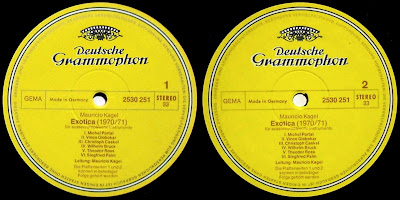Label:
Creative Works Records – CW 1009
Format:
Vinyl, Album, LP / Country: Switzerland / Released: 1987
Style:
Contemporary Jazz, Free Improvisation
Recorded
at Soundville Recording Studios, Luzern, January 1987.
Mastered
At – CBS Studios, London
Design
– Guy Bettini
Engineer
– René J. Zingg
Producer
– Werner Lüdi Sunnymoon
Liner
Notes Verfasser: Werner Lüdi
Matrix
/ Runout (Side A): CW 1009 A-1 SVS 206 A-1
Matrix
/ Runout (Side B): CW 1009 B
The
cover jacket has two large holes (front and back) and is printed inside so, if
it's empty, you can see a far moon in a black sky and a far sun in a clear sky.
Insert the inner sleeve and you get a black or white sky. Insert the double
insert and you may have a lunar footprint and a sun crown, or a globe with
trees and a second one with an ancient map on it, or a washing machine door and
an actress' nice face and so on.
side
A
A1
- Second Story Twilight : A Manhattan Melodrama .........................................
7:44
A2
- Jungle Moon In June .....................................................................................
5:12
A3
- Carolina Morning
...........................................................................................
4:51
side B
B1
- Macho Duck Disco ........................................................................................
6:06
B2
- Santorini Sailing Sun
.....................................................................................
5:45
B3
- Blindado Flying Circus ..................................................................................
5:18
Personnel:
Werner
Lüdi – alto saxophone
Hans
Koch – tenor saxophone, soprano saxophone
Stephan
Wittwer – electric guitar
Martin
Schütz – bass, cello
Dieter
Ulrich – drums, percussion, bugle
Werner
Lüdi (April 22, 1936 in Poschiavo, Graubünden – June 21, 2000 in Zurich) was a
Swiss jazz musician (alto and baritone saxophone) and author.
Lüdi
spent the early years of his life in Val Poschiavo and spent his youth in
Landquart, where he played accordion in a band. He became familiar with cool
jazz and played baritone saxophone in Tone Schädler's band. In 1958, he moved
to Hamburg, where he participated in jam sessions. In jam sessions, he got to
know Peter Brötzmann.
In
1964, he made a tour as an alto saxophonist with Gunter Hampel's band for one
year and then, he went to Munich, where he made jam sessions with Pierre Favre.
Then, he came back to Switzerland in 1966 and started to work as a photographer
in a public relations office and copywriter in an advertising agency.
In
1981, Lüdi came again to jazz scene and founded the group Sunnymoon with
Stephan Wittwer, Fredy Studer and Léon Francioli. In 1984, Hans Koch, Martin
Schütz, Timo Fleig and Lüdi played free improvisation in this group. Later,
Koch, Schütz, Lüdi and Paul Lovens performed together. At the end of 1980s, he
played with Mani Neumeier, Wädi Gysi and the trumpet player Mich Gerber as the
group Blauer Hirsch.
He
has performed also with Brötzmann's Märzcombo, Butch Morris, Sainkho
Namtchylak, Peter Kowald, William Parker, Saadet Türköz, Burhan Öçal, Peter
Conradin Zumthor and Daniel Seiler.
If
you find it, buy this album!


















































